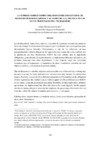Identificador persistente para citar o vincular este elemento:
https://accedacris.ulpgc.es/jspui/handle/10553/114138
| Título: | La imprescindible compatibilidad entre los sistemas de registro horario laboral y el derecho a la protección de datos personales del trabajador | Autores/as: | Montesdeoca Suárez, Arturo | Clasificación UNESCO: | 330413 Dispositivos de transmisión de datos 6306 Sociología del trabajo 560507 Derecho público |
Palabras clave: | Registro horario Jornada de trabajo Horas extraordinarias Protección de datos Datos biométricos, et al. |
Fecha de publicación: | 2022 | Proyectos: | PID2020-112731RB-I00 | Publicación seriada: | Iuslabor | Resumen: | La clarificación de forma fiable, objetiva y accesible de la jornada ordinaria de trabajo no
ha tenido siempre el mismo tratamiento puesto que inicialmente solo estaba previsto para determinadas figuras laborales. Precisamente, a raíz de los diferentes vaivenes jurisprudenciales sobre la obligación del registro horario se pone fin a este conflicto con la aprobación del Real Decreto - Ley 8/2019. En este sentido, ante la imposición obligatoria y generalizada del registro horario, se implementan diferentes aplicativos que permiten almacenar estos datos digitalmente. A este respecto, surge otra obligación secundaria para el empresario, el tratamiento de datos biométricos, cuestión que será objeto de análisis y discusión en el presente trabajo. The clarification in a reliable, objective and accessible way of the ordinary working day has not always had the same treatment since initially it was only foreseen for certain labor figures. Precisely, as a result of the different jurisprudentia l fluctuations on the obligation of time registration, this conflict is ended with the approval of Royal Decree-Law 8/2019. In this sense, given the generalized mandatory imposition of time registration, different applications are implemented that allow this data to be stored digitally. In this regard, another secondary obligation arises for the employer, the processing of biometric data, an issue that will be the subject of annalise and discussion in this paper. |
URI: | https://accedacris.ulpgc.es/handle/10553/114138 | ISSN: | 1699-2938 | DOI: | 10.31009/IUSLabor.2022.i01.07 | Fuente: | IUSLabor [ISSN 1699 - 2938], n. 1, p. 168-212 |
| Colección: | Artículos |
Los elementos en ULPGC accedaCRIS están protegidos por derechos de autor con todos los derechos reservados, a menos que se indique lo contrario.
